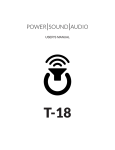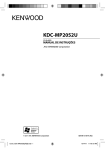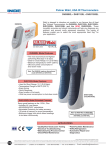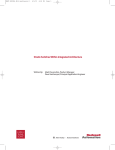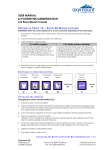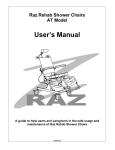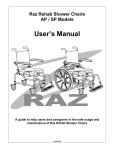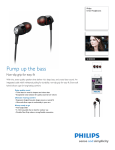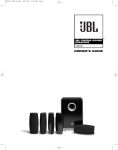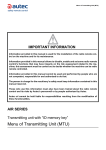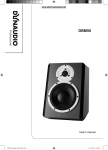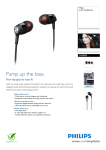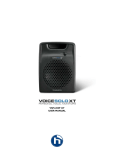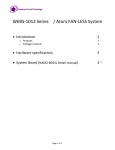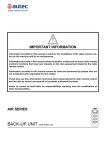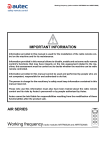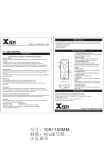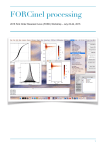Download power - Shopify
Transcript
USER’S MANUAL POWER XV30 XS30 SUBWOOFERS XV15 XS15 AVIS: CAUTION: FOR CONTINUED PROTECTION AGAINST RISK OF FIRE, REPLACE ONLY WITH SAME TYPE FUSE AND RATING. The lightning flash with arrowhead symbol is intended to alert the user to the presence of uninsulated “dangerous voltage” within the product’s enclosure that may be of sufficient magnitude to constitute a risk of electric shock to persons. The exclamation point symbol is intended to alert the user to the presence of important operating and maintenance (servicing) instructions in the literature accompanying the subwoofer IMPORTANT SAFETY INSTRUCTIONS 1. 2. 3. 4. 5. 6. 7. 8. 9. 10. 11. 12. 13. 14. 15. 16. 17. Read Instructions - All safety and operating instructions should be read before the subwoofer is operated. Retain Instructions - The safety and operating instructions should be retained for future reference. Heed Warnings - Adhere to all warnings on the subwoofer and in the operating instructions. Follow Instructions - All operating and use instructions should be followed. Water and Moisture - The subwoofer should not be used near water. Examples: near a bathtub, kitchen sink, in a wet basement, near a swimming pool or similar areas. Carts and Stands - The subwoofer should only be used with a cart or stand recommended by the manufacturer. When a cart is used, use caution when moving the cart/subwoofer combination to avoid injury from tip-over. Ventilation - The subwoofer should be situated so that its location or position does not interfere with its proper ventilation. Do not place the subwoofer in a cabinet or bookcase that may impede the flow or air through ventilation openings. Heat - The subwoofer should be situated away from heat sources such as radiators, heaters, heat registers, stoves, or any other device that produces heat. Power Sources - The subwoofer should be connected to a power supply only of the type described in the operating instructions or as marked on the subwoofer. Power Cord Protection - Power supply cords should be routed so they are not likely to be walked on or pinched by items placed upon or against them, paying particular attention to cords at plugs, convenience receptacles, and the point at which they exit from the subwoofer. Cleaning - The subwoofer should only be cleaned with a dry cloth. Non-Use Periods & Lightning Storms - The power cord of the subwoofer should be unplugged when left unused for a long period of time or during a lightning storm. Caution - Do not defeat the safety purpose of the polarized or grounding-type plug. A polarized plug has two blades with one wider than the other. A grounding type plug has two blades and a third grounding prong. The wide blade or the third prong are provided for your safety. If the provided plug does not fit into your outlet, consult an electrician for replacement of the obsolete outlet. Object and Liquid Entry - Care should be taken so that objects do not fall and liquids are not spilled onto the subwoofer. Only use attachments/accessories specified by the manufacturer. Damage Requiring Service - The subwofer should be serviced by qualified service personnell when: the power supply cord or plug has been damaged, objects have fallen or liquid has been spilled into the subwoofer, the subwoofer has been exposed to rain, the subwoofer does not appear to operate normally or exhibits a change in performance. Servicing - The user should not attempt to service the subwoofer beyond what is described in this manual or manufacturer supplied instructions. Welcome to the Power Sound Audio family. We are very excited to welcome you to the Power Sound Audio family. We would like to take this time to congratulate you on your purchase of a POWER subwoofer. We are confident that the Power Sound Audio subwoofer will meet and possibly exceed your expectations. WARNING! To prevent fire or shock hazard, do not expose this equipment to rain or moisture. To avoid electrical shock, do not remove the driver or amplifier from the enclosure. Please read all warnings on the subwoofer’s amplifier. There are no user serviceable parts inside the subwoofer. Please refer all service questions to techsupport@ powersoundaudio.com. Table of Contents Unpacking................................................................6 Placement................................................................7 Installation................................................................9 Warranty.................................................................14 Please read before unpacking your subwoofer. We suggest unpacking your Power Sound Audio subwoofer on a carpeted floor. This will avoid accidental scratches to a hard surface or to the subwoofer as you remove it from the shipping box. Your Power Sound Audio subwoofer may be very heavy. Please find assistance when needed, and be sure to use all proper lifting methods during the unpacking process (and whenever you move the subwoofer). 5 Unpacking Unpacking Process (XS15, XV15, & XS30 ONLY) 1. Inspect the shipping box for any damage. If you notice any damage please contact us at [email protected]. 2. With assistance, place the subwoofer upside down, so the UP arrows are pointing at the ground. 3. Carefully cut the tape on the bottom (now facing up) of the box with a knife or other sharp object. Be very careful not to cut too deep because you will damage the bottom of the subwoofer. 4. Fold back the cardboard flaps so the bottom of the enclosure is completely exposed. You can leave the foam corners in place if you prefer. 5. With assistance, rotate the shipping box so the open side of the box is now facing the floor. Make sure to keep the cardboard flaps folded back so they do not end up under the subwoofer. 6. With assistance, lift straight up on the shipping box to reveal your subwoofer. 7. Remove the plastic bag. 8. Remove and retain the foam packaging, the plastic covering, and the shipping box. 9. Visually inspect the subwoofer for any damage. If you notice any damage please contact us at support@powersoundaudio. com. Unpacking Process (XV30 ONLY) 1. Inspect the shipping box for any damage. If you notice any damage please contact us at [email protected]. 2. Carefully cut the straps that secure the subwoofer to the pallet. 3. With assistance, lift straight up on the shipping box to reveal your subwoofer. 4. With assistance, lift your subwoofer out of the shipping box and place it on a carpeted floor or blanket to prevent damage. 5. Remove the plastic bag. 6. Remove and retain the foam packaging, the plastic covering, and the shipping box. 7. Visually inspect the subwoofer for any damage. If you notice any damage please contact us at support@powersoundaudio. com. 6 Placement Proper placement of your new Power Sound Audio subwoofer is very important. Bass frequencies are non-directional, meaning the human ear cannot locate a properly functioning subwoofer in a typical home theater environment. While there are “rules of thumb” regarding placement options, every room is a little different. Please remember that each time you move the subwoofer to a different location you should recalibrate the bass levels and experiment a little to ensure the phase setting is optimized. Corner placement tends to work well, particularly if there are no large openings into the room near the corner. Another popular placement option is “nearfield”. Place the subwoofer as close as possible to the key seating positions. For example, place the subwoofer directly behind the sofa. Every room has its own set of acoustical challenges, so experiment with different placement options as much as time allows. One method that often works well (particularly if the key seating positions are in close proximity to one another) is to place the subwoofer in your key seating position and then walk around the room while a variety of bassy music and film play through the system. Mark the top 2 or 3 spots where the bass seems to sound best, then try the subwoofer in those spots. If you purchased a ported Power Sound Audio subwoofer (XV15 or XV30), please maintain a minimum of three inches of clearance between the port opening on your subwoofer and the nearest wall or obstruction. If you are using more than one subwoofer, placing them as close as possible (collocate) to one another will give you the maximum clean output capabilities, but separating them may give you smoother overall bass response at your seating positions. Again, experiment as much as time allows and decide which option sounds best to you. 7 Corner placement away from large opening Nearfield placement Multiple subwoofer placement Option 1 (collocated) Option 2 8 Installation Your subwoofer was designed for easy installation in a typical home theater environment. Please read all the installation instructions to properly optimize your subwoofer. WARNING - Always be sure the power is OFF to any audio component before connecting or disconnecting any wires or cables. This includes your receiver, processor, and subwoofer. 1 2 POWER 3 LFE 4 5 100-120V/220-240V ~50/60Hz 6.3A AVIS: CAUTION: 6 FORC ONTINUED PROTECTION AGAINST RISK OF FIRE, REPLACE ONLY WITH SAME TYPE FUSE AND RATING. ATTENTION: UTILISER UN FUSIBLE DE RECHANG E DE MEME TYPE ET CALIBRE. 9 FUSE T6.3A L 250V AMPLIFIER CONNECTIONS AND CONTROLS 1 POWER SELECTOR SWITCH OFF = The subwoofer amplifier is powered down. AUTO = Automatically powers up the subwoofer amplifer when a signal is sent from your receiver or processor. If a signal is not present, the subwoofer amplifier is put into stand-by mode. The subwoofer amplifier will draw a negligible amount of current while in stand-by. ON = Turns on the subwoofer and leaves it on. 2 GAIN CONTROL The GAIN control is used to adjust the output level of the subwoofer. This control should be set to a similar level as your loudspeakers in order to achieve a properly blended sound stage. Proper calibration procedures should be used to adjust the level of your subwoofer. 3 CROSSOVER CONTROL The CROSSOVER control is used to minimze the output of the subwoofer above the crossover’s setting. The crossover frequency is variable from 40Hz to 150Hz, with an LFE mode when turned fully clockwise. The LFE mode will bypass the subwoofer’s internal crossover and allow all filtering to be performed by your receiver or processor. 4 PHASE CONTROL The PHASE control is used to acoustically align the subwoofer with the main speakers. The phase setting is variable from 0 degrees to 180 degrees. 5 INPUTS The subwoofer INPUTS consist of LEFT/LFE and RIGHT RCA jacks. You only need to use the LEFT/LFE connection if you are using a receiver or processor with an LFE or subwoofer output. You can use a Y-connector on the subwoofer if it doesn’t power up in AUTO mode at low levels. (Please make sure to recalibrate if you use a Y-connector.) 6 IEC AC CONNECTOR The IEC AC CONNECTOR is where you connect the provided power cord. 10 CONNECTING YOUR SUBWOOFER WARNING - Always be sure the power is OFF to any audio component before connecting or disconnecting any wires or cables. This includes your receiver, processor, and subwoofer. Connecting your new subwoofer is relatively easy as long as you are using a modern DD/DTS 5.1 or 7.1 receiver or processor. Simply connect the subwoofer preout (RCA) on the rear panel of your receiver/processor to the LEFT/LFE input jack on the subwoofer amplifier. If you have a two channel stereo system please contact Power Sound Audio to discuss the best option to connect your new subwoofer. POWER LFE 100-120V/220-240V ~50/60Hz 6.3A AVIS: CAUTION: FORC ONTINUED PROTECTION AGAINST RISK OF FIRE, REPLACE ONLY WITH SAME TYPE FUSE AND RATING. ATTENTION: UTILISER UN FUSIBLE DE RECHANG E DE MEME TYPE ET CALIBRE. FUSE T6.3A L 250V RECEIVER/PROCESSOR PRE OUT FRONT SIDE REAR CENTER SUBWOOFER 11 SETUP PROCEDURES RECEIVER/PROCESSOR BASS MANAGEMENT OPTIONS Once the subwoofer is connected to your receiver or processor you should enter the “set up” menu and set all of your speakers to “small”. If they give you options for the crossover frequency e.g., 40hz, 60hz, 80hz, 100hz, start with 80hz. This will reroute all of the bass from your main speakers to the subwoofer. TURNING THE SUBWOOFER ON FOR THE FIRST TIME Please set the GAIN to minimum, the CROSSOVER control to 150HZ/ LFE, and the PHASE to 0. Move the power selector switch to ON. The power LED should now glow green. While listening to a bass heavy material, slowly increase the GAIN control until the overall bass levels sound natural to you. This will give you a starting point for the GAIN control. Typical setting is about the 1-2 o’clock position. GAIN SETTING Setting bass levels in your home system is usually accomplished in one of three ways: automatically by your receiver or processor, manually with your receiver or processors built-in test tones (or a test disc) and an SPL meter, or by ear. Auto-level adjustment Your receiver or processor will automatically adjust the output level of your subwoofer. You may need to adjust the GAIN on the subwoofer if it is too low or too high for the receiver or processor to correct. Please see your receiver or processor’s manual for instructions on automatically setting the GAIN on your subwoofer. Setting bass levels using a SPL meter This method tends to result in the most accurate bass volume. Simply hold the SPL meter about ear high while sitting in your key seating position. Activate the receiver or processor’s calibration test tones and watch the meter as the tones move from speaker to speaker. Unless your receiver or processor’s manual specifies otherwise, set all speakers, including the subwoofer, to the same output level. Setting bass levels by “ear” The best way to adjust the GAIN on your subwoofer is to use familiar bass heavy material. Use the receiver or processor’s remote control to manually adjust the bass levels to your preference. While it is human nature to want to really “HEAR” the bass from your brand new subwoofer, setting the levels to a more natural level will sound best in the long run. 12 SETUP PROCEDURES PHASE SETTING The PHASE control is used to properly blend the main speakers with the subwoofer through the crossover region. The goal is to adjust the PHASE control so the subwoofer driver moves in unison with the main speaker drivers through the crossover region. Think of it as a “timing delay” for the subwoofer driver. When experimenting with the phase setting the idea is to get the output from the subwoofer perfectly “in time” with the output from the rest of your speakers, primarily the left and right front speakers. If you have an SPL meter it is easy to optimize the phase setting. Set the SPL meter in your key seating position and play several “bassy” music tracks. While the music is playing SLOWLY turn the phase control and watch the SPL meter (you may need a friend for this). The highest reading is usually indicative of the best phase setting. If you don’t have an SPL meter, you can repeat the above process but simply use your ears to determine when the bass seems loudest. In this scenario, sit in your key seating position and have a friend SLOWLY turn the phase control. When the bass sounds loudest to you....you have the best phase setting! CROSSOVER SETTING The CROSSOVER control is an adjustable low pass filter. Output at frequencies above the crossover setting are minimized. This control is typically set to the fully clockwise position (LFE) and your receiver or processor performs all of the proper filtering. Please contact us if you need help adjusting the CROSSOVER control. 13 Warranty Power Sound Audio warrants its products to be free from original manufacturing defects in materials and workmanship for a period of 5 years from the original date of purchase. The warranty applies to the product and not the end user. If the product is transferred to another party, we ask that the new owner contact us with their information so we can update our records. Power Sound Audio will repair or replace any defective part with a new or refurbished part, free of charge, during the warranty period. If the product under warranty has been discontinued and cannot be repaired, Power Sound Audio will replace the original product with a product of equal or greater value, either new or refurbished. This warranty does not cover cosmetic damage, damage from improper use, accidents, abuse, misuse, acts of God, or unauthorized modifications. Please contact us if you need warranty service. Warranty Department [email protected] 14 15














